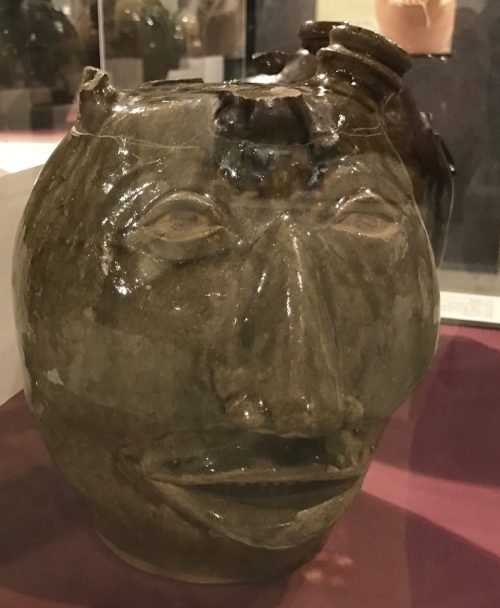Face Jugs
January 8, 2020By Tom Poland
Bulging whites with snake-eye slits for pupils and yellow teeth like chipped piano keys radiated light as if shadows could never exist. Its gruesome expression captured the way a face might look just before a bullet shatters skull bone and sends brain matter spattering. The angry face seemed about to utter a malediction. A curse, a jinx, was about to be mine.
That’s a shocking description I know. I’ve seen a good many face jugs but that first vintage jug, did it strike me as eerie? That’s an understatement. I felt just as I write above.

Note, this jug is not the one I describe. It’s representative of many face jugs.
Why would anyone put a face on stoneware? Might the face be a rendering of a deceased family member, a visage of a voodoo priest, or a way to ward off evil spirits? All of the above?
After researching a book for well over three years I know a bit more about what some folks call face jugs, ugly jugs, and voodoo pots. By far, face jugs are the strangest pieces of pottery people collect. I find them beautifully grotesque, a bewitching face frozen in the midst of a nightmare. I learned that African-Americans placed them by doors, on steps, and on gravesites. Before the Civil War, slaves’ graves went unmarked. Now just why was that? I have no idea, but I read that face jugs were sometimes placed on slaves’ graves. The jugs represented a kind of marker and warded off evil spirits. I came across a reference to a South Carolina potter who traced his ancestors to slavery. According to him, a face jug was ugly enough to scare the devil away from your grave. That gave your soul a chance to go to heaven.
This evil spirit thing goes back to Haiti where some slaves passed through to North America on their voyage from western Africa. In Haiti, they encountered voodoo and brought that cult of sorcery and spirit possession to the colonies.
I don’t know if these vessels hold spells. I want to think they do. For certain they hold money. The Metropolitan Museum of New York acquired one such jug for $85,000.
The history of face jugs goes all the way back to the fourteenth century. These unusual ceramic vessels first appeared in the American South in the mid-1800s. And it was in Edgefield, South Carolina, where slaves threw many of these strange pots. Academics believe the vessels had religious or burial significance, or they reflected the emotions people experienced while living under harsh conditions.
Taking note of vintage face jugs, white southern potters got in on the act around the close of the 1800s. A lot of potters throw face jugs today, but their pots don’t startle me. The vintage ones, however, strike me as stranger than strange. I’ve seen Catawba stoneware with snakes coiled around their opening, but face jugs with their bizarre faces give me a chill. I tread around them with reverence, and I catch myself staring at a face that seems to stare back. Face jugs, yet another aspect of our tumultuous history down South. Yet another colorful, if disturbing, example of how the hands of man shape Mother Earth into art.
Visit Tom Poland’s website at www.tompoland.net
Email Tom about most anything. [email protected]
Tom’s work appears in publications throughout the South. His books include South Carolina Country Roads, Classic Carolina Road Trips From Columbia, Georgialina, A Southland, As We Knew It, and Reflections of South Carolina, Vol. II. He writes about the South, its people, traditions, lifestyle, and culture. He’s member of the SC Humanities Speaker’s Bureau. Governor Henry McMaster conferred the Order of the Palmetto upon Tom for his body of work on South Carolina. Tom grew up in Lincoln County, Georgia, and graduated from the University of Georgia. He lives in Irmo, South Carolina.




















